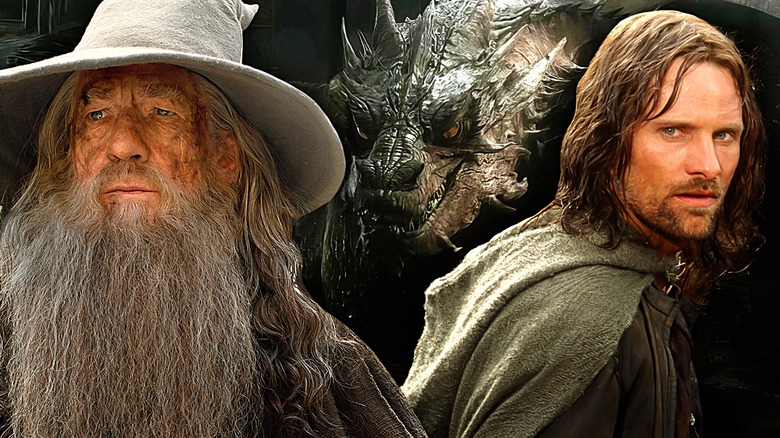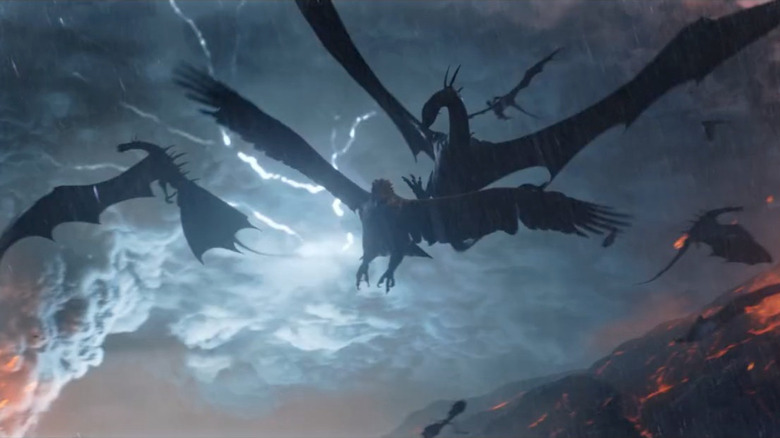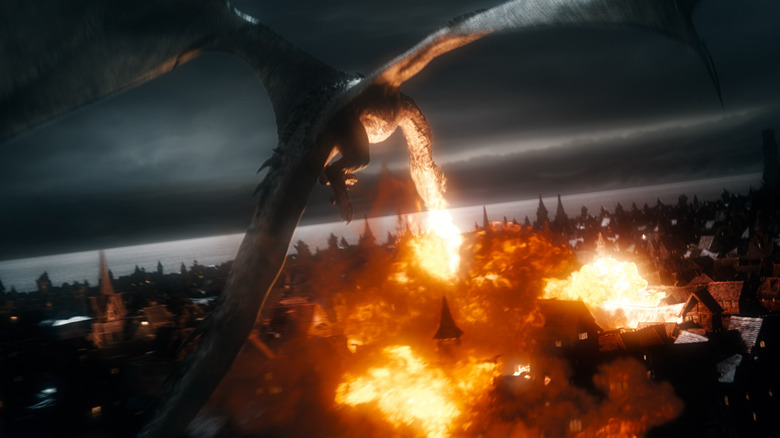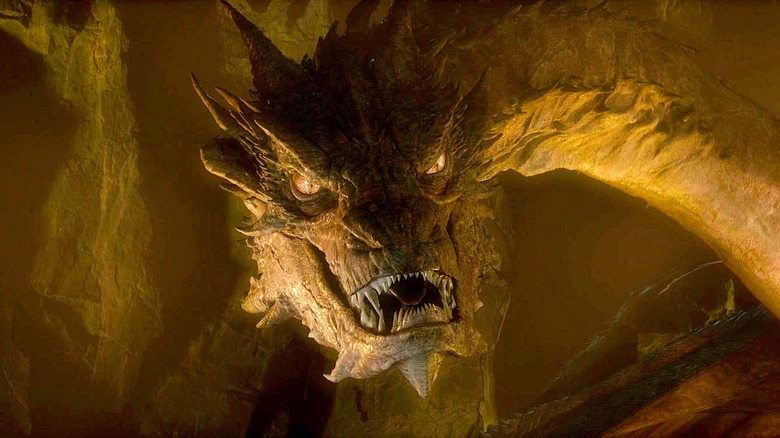What Really Happened To The Dragons In The Lord Of The Rings
"The Lord of the Rings" is filled with creatures of all types. Ents, Eagles, Oliphaunts, Wargs, and even the Watcher in the Water all have their place in the story. But what about dragons? Where do they come into Tolkien's canon, and where do they stand after the One Ring is cast into the fire?
The easiest answer is that, well, we just don't know. Tolkien doesn't give a definitive resolution to the dragon question. That said, the two most famous and involved of the fire-breathing dragons, or "Urulókë" in Elvish, exist at the beginning and end of his stories, practically bookending the narrative and showing that their race can go the distance, even if they typically are kept off-screen.
Let's take a look at what we do know about the history of dragons and see if we can come to a relatively satisfactory answer about what ultimately happened to them during and after "The Lord of the Rings."
A brief history of dragons
The history of dragons starts a quarter of a millennium into the First Age of Middle-earth history. At this point, the dragon Glaurung emerges from the then-Dark Lord Morgoth's stronghold. Glaurung is called "The Father of Dragons," and "The Silmarillion" says that at the time, "He was yet young and scarce half-grown, for long and slow is the life of the dragons." Glaurung is initially defeated but ultimately becomes a fearsome commander in Morgoth's armies, causing death and destruction everywhere he goes before he's killed in single combat by the Human hero Túrin Turambar.
Throughout the First Age, the earliest dragons (including Glaurung) are not winged. They are earth-borne demons until the War of Wrath (the age-ending battle where Morgoth is defeated). During that fight, "The Silmarillion" says winged dragons appear for the first time, led by Ancalagon the Black, who is described as the "greatest of the winged dragons of Morgoth." Despite his size, Ancalagon is killed in the fighting, this time by Elrond's dad, Eärendil. Many of Ancalagon's fellow dragons don't survive the battle, either, and the remainder flee.
Dwarves, Men, and Dragons
After the War of Wrath, the Second Age of Middle-earth history begins. "The Silmarillion" explains that at the beginning of this period, "Men dwelt in darkness and were troubled by many evil things that Morgoth had devised in the days of his dominion: demons, and dragons, and misshapen beasts, and the unclean Orcs that are mockeries of the Children of Ilúvatar. And the lot of Men was unhappy."
While the specific timing and manner of their migration isn't clear, at some point along the way, many dragons appear to have moved to the bitter, barren northern regions of Middle-earth. At least, this is the area where all of their remaining activity takes place. That said, this is the part of the story where the data becomes more sparse. For instance, in "The Fellowship of the Ring," Gandalf indicates that Sauron has gathered all of the Dwarven rings that haven't already been destroyed by dragon fire (one of the few things hot enough to melt most Rings of Power). Working backwards, we can then assume that dragons have destroyed some of the rings, which means at some point they were attacking Dwarves after those trinkets were made halfway through the 3,500-year-long age. Despite indirect hints like these, for most of the Second Age and the next, the dragons stay below the radar.
Once we get toward the end of the 3,000-year-long Third Age that follows, more dragons pop up. The appendices to "The Return of the King" say around two millennia into that age, an ancient Rohirric king named Fram defeats a dragon with the badass name Scatha. It adds that around the 2,570th year of the age, "Dragons reappear in the far North and begin to afflict the Dwarves." 20 years later, the Dwarven King Dáin I is killed by a dragon. Then, two hundred years after their re-appearance, Smaug flies south to the Lonely Mountain, and the rest is history.
There is no sign dragons are done by the end of the story
Okay, so there are plenty of signs of dragons before "The Lord of the Rings." Once Bard fells Smaug with his famous black arrow, though, it seems to put the kibosh on dragon history. Are they done at that point? Was Smaug the last of his kind? No and no.
In "The Hobbit" book, Thorin describes the situation to Bilbo, saying, "There were lots of dragons in the North in those days, and gold was probably getting scarce up there, with the dwarves flying south or getting killed, and all the general waste and destruction that dragons make going from bad to worse." He then clarifies, "There was a most specially greedy, strong and wicked worm called Smaug." So, by this time, there are still multiple dragons around. Smaug is simply one of the biggest and baddest of the lot.
Half a century later, Gandalf refers to dragons again — in the present tense. In "The Fellowship of the Ring" book, the Wizard says, "It has been said that dragon-fire could melt and consume the Rings of Power, but there is not now any dragon left on earth in which the old fire is hot enough." The wording clearly implies that there are some dragons around — they're just not up for ring-melting.
So, let's recap. Dragons appear early in Middle-earth history and are steadily involved during the First Age. Part-way through the Second Age, they go quiet, lying low for several thousand years, until they re-emerge and start traumatizing the Dwarves 2,500 years into the Third Age. They stay tangentially involved in the northern Middle-earth historical narrative for the next five hundred years and, presumably, are still kicking around their northern stomping grounds when the story ends. So, the next time you're asked what happened to the dragons in "The Lord of the Rings," the answer is simple: they're probably still there.



